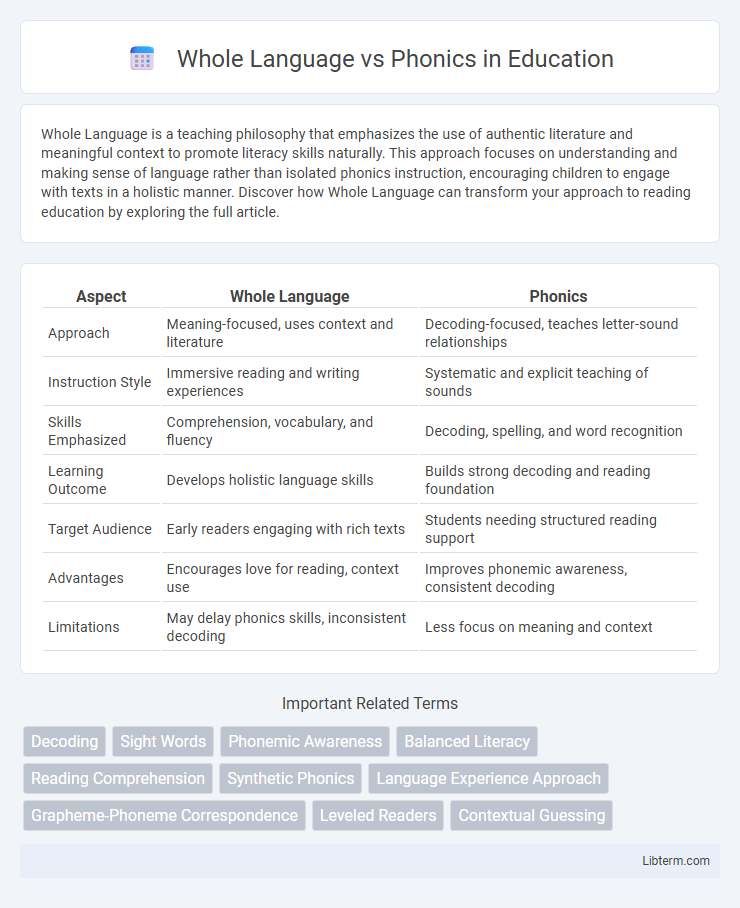Whole Language is a teaching philosophy that emphasizes the use of authentic literature and meaningful context to promote literacy skills naturally. This approach focuses on understanding and making sense of language rather than isolated phonics instruction, encouraging children to engage with texts in a holistic manner. Discover how Whole Language can transform your approach to reading education by exploring the full article.
Table of Comparison
| Aspect | Whole Language | Phonics |
|---|---|---|
| Approach | Meaning-focused, uses context and literature | Decoding-focused, teaches letter-sound relationships |
| Instruction Style | Immersive reading and writing experiences | Systematic and explicit teaching of sounds |
| Skills Emphasized | Comprehension, vocabulary, and fluency | Decoding, spelling, and word recognition |
| Learning Outcome | Develops holistic language skills | Builds strong decoding and reading foundation |
| Target Audience | Early readers engaging with rich texts | Students needing structured reading support |
| Advantages | Encourages love for reading, context use | Improves phonemic awareness, consistent decoding |
| Limitations | May delay phonics skills, inconsistent decoding | Less focus on meaning and context |
Introduction to Whole Language and Phonics
Whole Language emphasizes understanding and meaning by immersing children in rich literary experiences, encouraging context clues and holistic reading. Phonics focuses on decoding skills through systematic instruction of letter-sound relationships, enabling accurate word recognition. Both approaches aim to develop proficient reading but prioritize different foundational techniques.
Historical Overview of Reading Instruction
The historical debate between Whole Language and Phonics approaches to reading instruction emerged prominently in the 20th century, with phonics gaining early 1900s dominance due to its systematic focus on decoding skills. Whole Language rose as a prominent alternative during the 1980s and 1990s, emphasizing context, meaning, and exposure to rich literature rather than explicit sound-letter relationships. Research synthesis and educational policy in the early 21st century increasingly advocated for balanced literacy programs, integrating systematic phonics instruction with whole language elements to optimize reading comprehension and fluency development.
Core Principles of Whole Language
Whole Language emphasizes learning to read through exposure to complete texts, promoting meaning-making and contextual understanding rather than isolated phonetic instruction. Its core principles include fostering a literacy-rich environment, encouraging natural language acquisition through authentic reading and writing experiences, and integrating reading with listening and speaking skills. This holistic approach prioritizes comprehension and the use of language in meaningful contexts over systematic phonics drills.
Core Principles of Phonics
Phonics centers on the systematic relationship between letters and sounds, emphasizing the decoding of words through explicit instruction in phonemes and graphemes. Core principles include teaching letter-sound correspondences, blending sounds to form words, and segmenting words into individual phonemes to enhance reading fluency and word recognition. This approach contrasts with Whole Language by prioritizing skill-based learning and structured practice over contextual guessing and immersive text exposure.
Key Differences Between Whole Language and Phonics
Whole Language emphasizes meaning, context, and natural reading experiences, encouraging children to recognize words as whole pieces of language, while Phonics focuses on systematic instruction of letter-sound relationships and decoding skills. Whole Language advocates for immersion in rich, authentic texts to develop reading fluency, contrasting with Phonics' structured and sequential teaching of sounds and blending techniques. Research shows Phonics is particularly effective in early literacy for decoding and word recognition, whereas Whole Language supports comprehension and vocabulary development through exposure to meaningful language contexts.
Benefits of Whole Language Approach
The Whole Language approach enhances literacy by promoting reading comprehension through exposure to complete texts, allowing learners to understand context and meaning naturally. This method supports language development by integrating speaking, listening, reading, and writing, fostering a more holistic communication skill set. Emphasizing authentic literature encourages motivation and engagement, leading to improved fluency and a deeper connection with reading material.
Advantages of Phonics-Based Instruction
Phonics-based instruction enhances decoding skills by teaching the relationship between letters and sounds, which accelerates reading fluency and accuracy. It provides a systematic approach that supports learners in recognizing unfamiliar words independently, fostering strong foundational literacy. Research consistently shows that phonics instruction improves reading comprehension by enabling students to efficiently decode text and grasp meaning.
Criticisms and Limitations of Each Method
Whole Language faces criticism for its heavy reliance on context and visual cues, which can impede the development of essential decoding skills in early readers. Phonics is often criticized for its rigid focus on letter-sound relationships, potentially neglecting comprehension and the natural flow of language. Both methods show limitations: Whole Language may underprepare students for unfamiliar words, while Phonics might overlook the importance of meaning and language experience in literacy acquisition.
Current Trends in Literacy Education
Current trends in literacy education emphasize a balanced approach that integrates Whole Language and Phonics methods, recognizing the value of both decoding skills and contextual comprehension. Evidence-based research highlights that explicit phonics instruction improves word recognition and reading fluency, while Whole Language strategies support vocabulary development and meaning-making. Educators increasingly adopt hybrid frameworks combining systematic phonics with rich language experiences to enhance overall literacy outcomes.
Finding the Right Balance: Integrative Reading Strategies
Finding the right balance between Whole Language and Phonics involves integrating immersive text experiences with systematic decoding skills to support comprehensive literacy development. Research highlights that combining context-rich reading practices with explicit phonics instruction enhances word recognition, fluency, and comprehension in diverse learners. Effective integrative reading strategies tailor instruction to individual student needs, promoting engagement while building foundational decoding proficiency.
Whole Language Infographic

 libterm.com
libterm.com